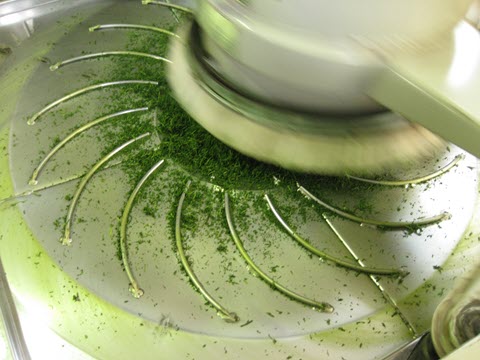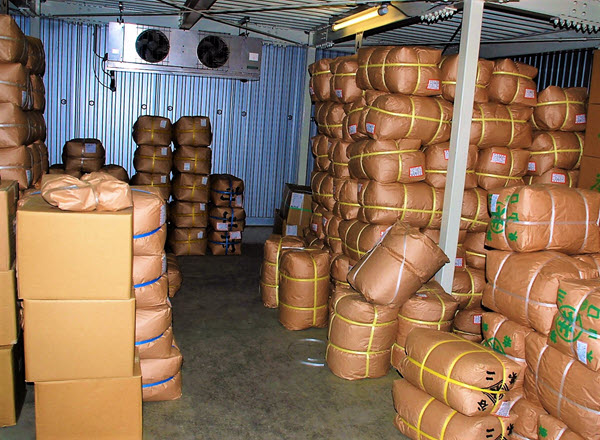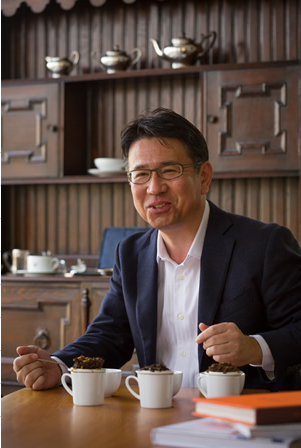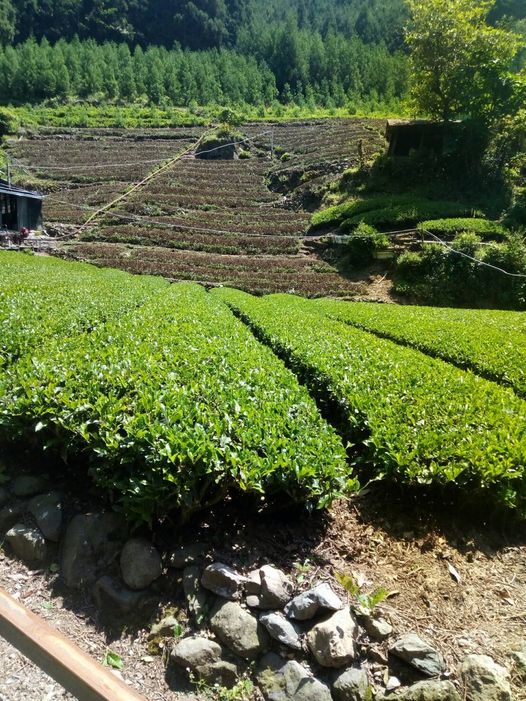
Production Fields are Mechanically Harvested
By Ian Chun | Yunomi Life
With clockwork precision, the Shinkansen—Japan’s Bullet Train—smoothly pulled in to the Kakegawa train station. The trip from Tokyo to the heart of Japan’s tea production region operated with the characteristic technological sophistication that is this country’s trademark. While the image of tea leaf pluckers wandering among ordered rows of tea plants (beneath the benevolent gaze of the majestic Mount Fuji) pervade industry advertising, the foundation of Japan’s tea industry has been its incorporation of new technology. It has been apparent in the incorporation of shading in the cultivation of tea leaves in the 16th century, to the development of steaming and rolling in 1738 by Nagatani Souen, to the invention of machines to mechanize the laborious six-hour sencha hand-rolling process by Takabayashi Kenzo in the late 19th century.

In the late 20th century, as Japan urbanized and the farm worker population plunged, as the average age of farmers crept upward to 68 years old in 2020, the development and incorporation of new technologies to maintain productivity and quality has been important to the health of the tea industry.
In the fields, we see tractor like tea trimmers and harvesters, in the modern processing factories, the machinery allows for the finest adjustments to account for differences in the leaves, and in the daily weather — the craft of tea creation combined with technology to supply an entire nation.
Perhaps the area of development that gets the least attention are the technologies used to preserve tea quality. Hashimoto Naoyuki, international sales director at Maruyama Tea in Kakegawa, Shizuoka, explained the technology behind the refiner and wholesaler’s tea quality. “Green tea,” he explains, “still has about 5% moisture content in the leaf when we purchase it from the production factories. We need to store it at low temperature or the flavor quality will go bad in a few months after harvest.”

Maruyama installed its first -25C refrigerator in 1996. Hashimoto-san showed me a few of their storage facilities where the rooms are ordered in levels of temperature — 10C to 0C to -20C. Asked if there is an ideal temperature for tea storage, he replied, “The colder the better, but colder temperatures require more energy and so has a higher maintenance cost.”
He pointed to the large fans at the ceiling blowing in the sub-zero air.
“And when you remove the tea, you need to do it in stages. Japanese summers are very humid so you have to slowly acclimate the leaf to room temperature before handling it.”
The tea leaves at this state is called aracha, literally “rough tea”; it is tea at its unfinished state, and besides removing stems and broken leaf bits to refine the aracha, Maruyama Tea’s facility also green roasts the leaf (in Japanese hi-ire, pronounced “hee-ee-reh”). By controlling the roasting time and temperature, refiners are able to add different levels of sweet toastiness to a green tea leaf. More importantly, the reduction of the moisture content in the leaf to 1-2% guarantees that the leaf quality will last for at least a year on store shelves without significant decline in quality. This process allows the manufacturer to prepare (green roast) leaf at anytime after harvest to start the clock for maximum quality. After green roasting, the leaves are nitrogen flushed and vacuum packed to remove as much oxygen as possible to maintain best quality, and placed back into the refrigerated storage rooms to await shipment.
The other very impressive aspect of Maruyama’s facilities is the level cleanliness— the FSSC22000 level cleanliness, a food safety standard, requires workers to dress in protective suits, and undergo an air shower before entering the clean room environment for leaf processing and packaging. This helps to ensure a sanitary, dust-free environment for refining tea and grinding matcha.

Yakuji Maruyama Tsuyomatsu, the founder of Maruyama Japanese Tea, learned his tea making skills working for Kyoyeki-Sha prior to establishing Maruyama Tea in 1933. Maruyama has always believed in creating a cupful of tradition and innovation. This philosophy led the company to work with local farmers to master deep-steam sencha, a Kakegawa cultivar shaded for a few days prior to harvest and then steamed for 45- to 60-seconds to make Fukamushi Sencha. President and heir Katsuhisa Maruyama continues the company’s tradition of technological innovation.

Matcha is a mainstay for Germany’s Wollenhaupt Tee
Marco Sinram, head of tea trading at Wollenhaupt, a Hamburg-based supplier of Japanese tea, writes that family-owned Wollenhaupt and Maruyama share a similar ownership structure and philosophy in management style.
![]()
Wollenhaupt imports Japanese teas exclusively from Maruyama. “Since 2018 we have entered ever-closer cooperation to focus on promoting Japanese teas to the western markets,” said Sinram. Wollenhaupt, founded in 1881 and Maruyama, founded in 1933, retain traditional values and time-honored practices while embracing technology and production efficiency.
Last year Wollenhaupt constructed a large volume, cold-chain distribution hub to ensure timely tea delivery on short notice. Tencha, processed in Japan using traditional horticultural practices, is ground only when it needs to be packed against an order. Until then, it remains as the raw material, stored at minus 20°C,” said Sinram.
He explained that Maruyama’s ability to nitrogen flush and vacuum pack tea is critical to meeting the expectations of beverage and culinary matcha clients in 70 countries. Shipments arrive every eight weeks. On arrival Wollenhaupt refrigerates teas at a constant temperature below 8°C. Container lots and a regular shipping schedule lower costs, and “stock never stays too long. This ensures absolute fresh quality to the customer,” writes Sinram.
Learn more at www.wollenhaupt.com.
Click for link to share this post
Click to view Tea Biz newsletter archive
Signup and receive Tea Biz weekly in your inbox.
Never miss an episode
Subscribe wherever you enjoy podcasts:











